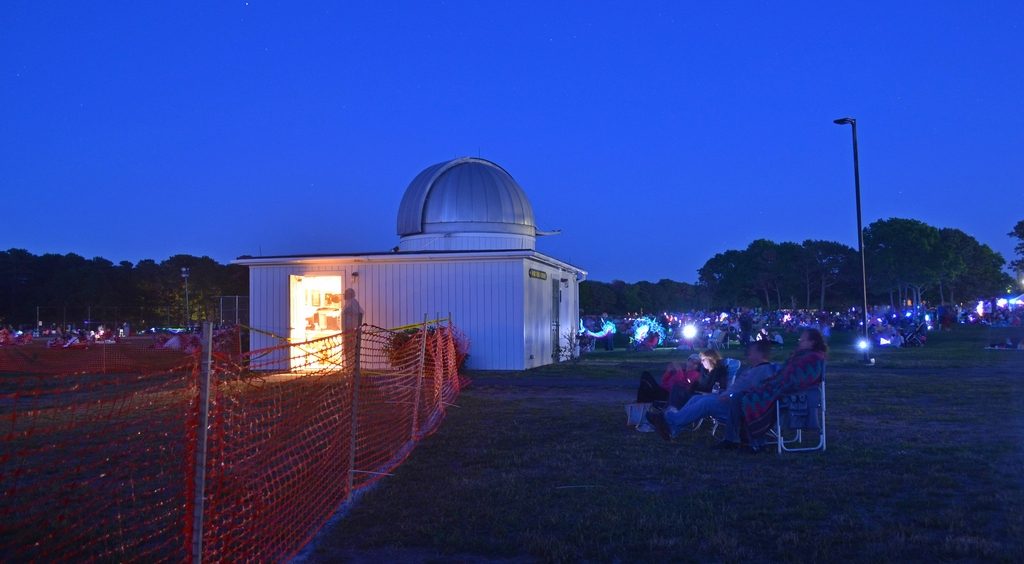Werner Schmidt Observatory staff hosts
public Star Parties and Special Events

Details.
The schedule for star parties, meetings and special events will be posted on the CCAS website Home Page and calendar. For those new to amateur astronomy, a description of our star parties is listed in the next section. While we try not to cancel star parties, a solid forecast of total cloud cover, snow, rain or high wind will result in cancellation. If in doubt about the weather, call 508-398-4765 during the event — no answer means the event has been cancelled. A priori cancellations may also be reflected on the calendar.
Special events will be planned at the observatory on occasion, sometimes in league with other local schools and clubs. The last partial solar eclipse and the transit(s) of Mercury are good examples of such events we have held.
The lower level of the observatory is called the warm room and is heated. It has a large flat screen display of the astronomical objects that are being imaged by our main scope in the Dome. Up in the Dome room there is no heat and it has the same temperature as outside — it will be cold during the winter season. Dress warmly if you wish to go up to the dome! The same holds if you wish to go outside and observe with the small scopes and/or binoculars in the winter. In the summer, please remember to bring some insect repellent!
There are no fees or applications needed to attend our public star parties – just come and enjoy the night sky with us!
Location:
Werner Schmidt Observatory
210 Station Ave
Dennis-Yarmouth High School
South Yarmouth, MA 02664
If you wish to schedule a party for your organization, please contact us. Staff is limited and we may not be able to fill everyone’s requests, but we certainly will try.
“What is a Star Party?”
Observatory staff members, who are experienced amateur astronomers with knowledge of the night sky and our equipment, open the Werner Schmidt Observatory to guests for two to three hours.
If it is clear, visitors have supervised access to the big, permanently mounted 12 1/2″ (diameter) PlaneWave telescope up in our Dome. We also may have as many as four other telescopes out on the lawn. Sometimes visitors bring their own telescopes or binoculars. We look at all things in the sky from constellations to the moon and planets to extra-solar-system objects far beyond. We even have daytime “Local Star Parties” where the “star” is our sun and we view it and its phenomena using special solar telescopes.
When guests arrive, staff members try to start one-on-one conversations with them, either inside or outside. Those discussions usually lead to moving to one of our scopes where we begin to look at and discuss targets in the sky which fit with the interests and sky gazing experience of the guests.
We plan to have one star party each month during the week of the New Moon, weather permitting. Details are on the Home Page.
Who are our visitors? What can they see?
They are both members of the Society and also anyone wishing to visit; now and then, an experienced amateur astronomer or even a professional astronomer or professor. More commonly though, it is folks who’ve learned, “Hey, there is an astronomical observatory at the Dennis-Yarmouth Regional High School… let’s go check it out.” We do great with kids over about five years old if they are accompanied by adults. There is nothing more fun for our Staff Members than the big “Wow!” we’ll get from a youngster the first time they (or even “older” folks) see a crater on the moon or the rings of Saturn.
On a typical night we might have fifteen or so visitors. This is a small enough number so that we are able to give our guests individual attention.
One part of our presentation, in addition to the telescopes, is a “pointer and binocular sky tour.” If folks are new to the night sky we will usually start looking at constellations (e.g, Ursa Major or its commonly known asterism, “The Big Dipper”), point to specific bright stars with a laser pointer, and then look through one of our ‘scopes at whatever might be fun to examine in a given constellation. For the more knowledgeable and experienced, we might search for and observe distant planets like Neptune, nebulae, star clusters, and distant galaxies. But no matter how knowledgeable, everyone enjoys Jupiter and its moons and Saturn and its rings!
As mentioned, we have lots to show and do inside as well. In addition to the flat screen showing our main scope’s images, we also have videos of special sights and observing projects from previous observing nights. We also provide some detailed explanation of how all the equipment at WSO works, as well as discuss the science of the astronomical wonders we are observing.
